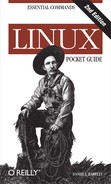Name
printf — stdin stdout - file -- opt --help --version
Synopsis
printfformat_string[arguments]
The printf command is an
enhanced echo: it prints
formatted strings on standard output. It operates much like the C
programming language function printf(
), which applies a format string to a sequence of
arguments to create some specified output. For example:
$ printf "User %s is %d years old. " sandy 29 User sandy is 29 years old.
The first argument is the format string, which in our example
contains two format specifications, %s and %d. The subsequent arguments, sandy and
29, are substituted by printf
into the format string and then printed. Format specifications can
get fancy with floating-point numbers:
$ printf "That'll be $%0.2f, sir. " 3 That'll be $3.00, sir.
There are two printf
commands available in Linux: one built into the bash shell, and one
in /usr/bin/printf. The two are
identical except for one format specification, %q, supported only by the bash built-in:
it prints escape symbols (“”) so its output can
be used as shell input safely. Note the difference:
$ printf "This is a quote: %s " """ This is a quote: " $ printf "This is a quote: %q " """ This is a quote: "
It is your responsibility to make sure the number of format
specifications (%) equals the
number of arguments supplied to printf. If you have too many arguments,
the extras are ignored, and if you have too few, printf assumes default values (0 for
numeric formats, an empty string for string formats). Nevertheless,
you should treat such mismatches as errors, even though printf is forgiving. If they lurk in your
shell scripts, they are bugs waiting to happen.
Format specifications are described in detail on the manpage
for the C function printf (see
man 3 printf). Here are some
useful ones.
|
|
Decimal integer |
|
|
Long decimal integer |
|
|
Octal integer |
|
|
Hexadecimal integer |
|
|
Floating point |
|
|
Double-precision floating point |
|
|
A single character |
|
|
String |
|
|
String with any shell metacharacters escaped |
|
|
A percent sign by itself |
Just after the leading percent sign, you can insert a numeric expression for the minimum width of the output. For example, “%5d” means to print a decimal number in a five-character-wide field, and “%6.2f” means a floating-point number in a six-character-wide field with two digits after the decimal point. Some useful numeric expressions are:
|
|
Minimum width
|
|
|
Minimum width
|
|
|
Minimum width
|
printf also interprets
escape characters like “
” (print a newline character) and “a”
(ring the bell). See the echo
command for the full list.
